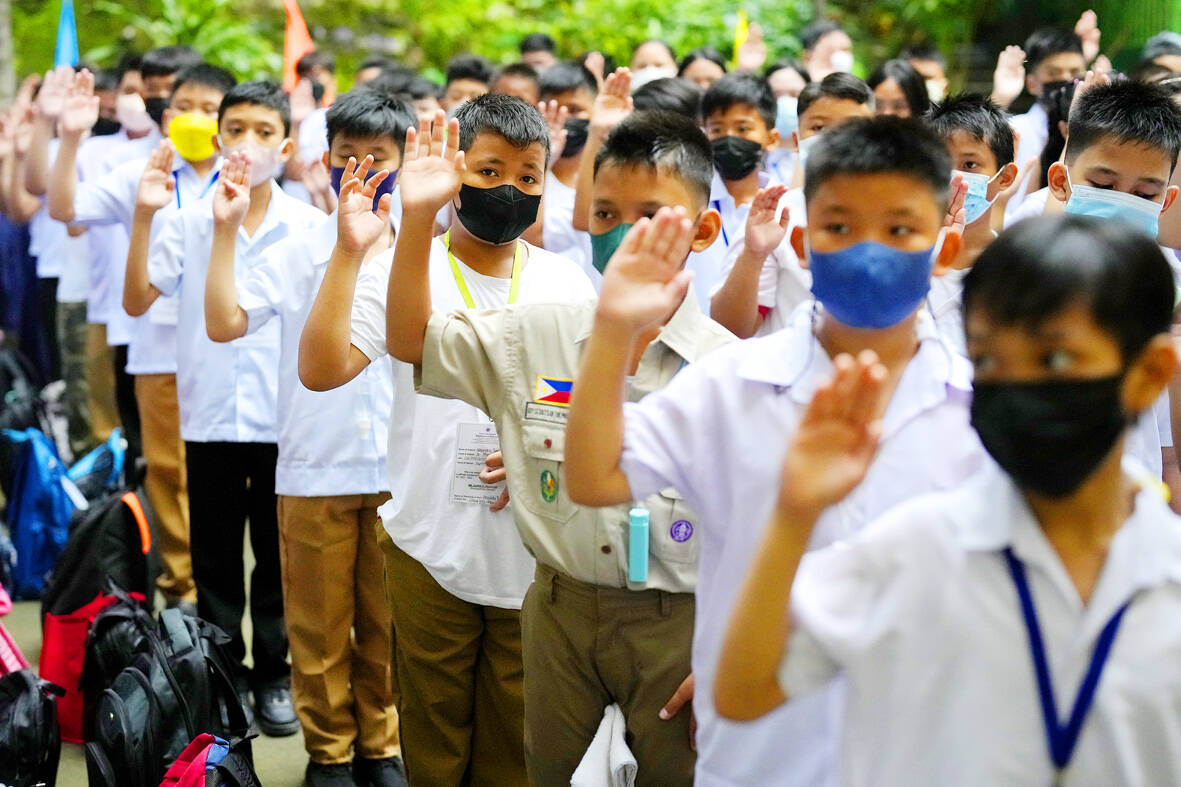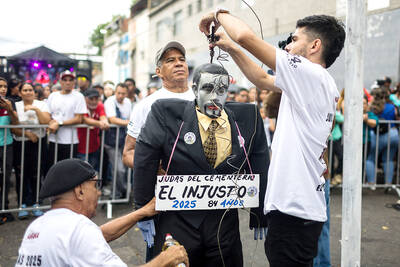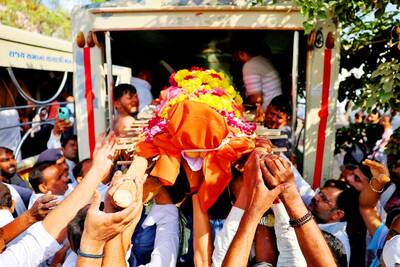Millions of students wearing masks streamed back to primary and secondary schools across the Philippines yesterday in their first in-person classes after two years of COVID-19 lockdowns that are feared to have worsened one of the world’s most alarming illiteracy rates among children.
Officials grappled with daunting problems including classroom shortages, lingering COVID-19 fears, an approaching storm and quake-damaged school buildings in the country’s north, to welcome back many of more than 27 million students who enrolled for the school year.
Only about 24,000 of the nation’s public schools, or about 46 percent, are able to open in-person classes five times a week, while the rest must resort to a mix of in-person and online classes until Nov. 2, when all public and private schools are required to bring all students back to classrooms, education officials said.

Photo: AP
About 1,000 schools are unable to shift to face-to-face classes entirely during the transition period ending on Nov. 2 for various reasons, including damage to schools wrought by a powerful earthquake last month in the north, officials said.
The Department of Education said some schools would have to divide classes in three shifts a day due to classroom shortages, a longstanding problem, and to avoid overcrowding that could turn schools into new epicenters of COVID-19 outbreaks.
“We always say that our goal is maximum of two shifts only, but there will be areas that would have to resort to three shifts because they’re really overcrowded,” Education Department spokesperson Michael Poa said on Friday at a news conference.
Despite many concerns, education officials gave assurances that it is “all-systems go” for yesterday’s resumption of classes, he said.
Philippine Senate Majority Leader Joel Villanueva said such assurances have to be matched by real improvements.
“The era of missing classrooms, sharing tables and chairs, and holding classes under the shade of trees must no longer happen,” said Villanueva, who filed two bills calling for additional grocery, transportation and medical allowances for public-school teachers.
Among the worst-hit by the COVID-19 pandemic in Southeast Asia, the Philippines under former president Rodrigo Duterte enforced one of the world’s longest lockdowns and school closures. Duterte, whose six-year term ended on June 30, had turned down calls for reopening in-person classes due to fears that it might ignite new outbreaks.
The prolonged school closures sparked fears that literacy rates among Filipino children — which were already at alarming levels before the pandemic — could worsen.
A World Bank study last year showed that about 90 percent of children in the Philippines were suffering from “learning poverty,” or the inability by age 10 to read and understand a simple story.
“Prolonged school closures, poor health risk mitigation, and household-income shocks had the biggest impact on learning poverty, resulting in many children in the Philippines failing to read and understand a simple text by age 10,” UNICEF Philippines said in a statement.
“Vulnerable children such as children with disabilities, children living in geographically isolated and disadvantaged areas, and children living in disaster and conflict zones fare far worse,” the UN agency for children said.
Poa said 325 temporary “learning spaces” were being constructed in northern Abra province and outlying regions to replace school buildings battered by a powerful July 27 quake.
Education officials also scrambled to help more than 28,000 students look for new schools after at least 425 private schools closed permanently since the pandemic’s arrival in 2020, mainly due to financial losses.

POLITICAL PRISONERS VS DEPORTEES: Venezuela’s prosecutor’s office slammed the call by El Salvador’s leader, accusing him of crimes against humanity Salvadoran President Nayib Bukele on Sunday proposed carrying out a prisoner swap with Venezuela, suggesting he would exchange Venezuelan deportees from the US his government has kept imprisoned for what he called “political prisoners” in Venezuela. In a post on X, directed at Venezuelan President Nicolas Maduro, Bukele listed off a number of family members of high-level opposition figures in Venezuela, journalists and activists detained during the South American government’s electoral crackdown last year. “The only reason they are imprisoned is for having opposed you and your electoral fraud,” he wrote to Maduro. “However, I want to propose a humanitarian agreement that

ECONOMIC WORRIES: The ruling PAP faces voters amid concerns that the city-state faces the possibility of a recession and job losses amid Washington’s tariffs Singapore yesterday finalized contestants for its general election on Saturday next week, with the ruling People’s Action Party (PAP) fielding 32 new candidates in the biggest refresh of the party that has ruled the city-state since independence in 1965. The move follows a pledge by Singaporean Prime Minister Lawrence Wong (黃循財), who took office last year and assumed the PAP leadership, to “bring in new blood, new ideas and new energy” to steer the country of 6 million people. His latest shake-up beats that of predecessors Lee Hsien Loong (李顯龍) and Goh Chok Tong (吳作棟), who replaced 24 and 11 politicians respectively

Young women standing idly around a park in Tokyo’s west suggest that a giant statue of Godzilla is not the only attraction for a record number of foreign tourists. Their faces lit by the cold glow of their phones, the women lining Okubo Park are evidence that sex tourism has developed as a dark flipside to the bustling Kabukicho nightlife district. Increasing numbers of foreign men are flocking to the area after seeing videos on social media. One of the women said that the area near Kabukicho, where Godzilla rumbles and belches smoke atop a cinema, has become a “real

‘WATER WARFARE’: A Pakistani official called India’s suspension of a 65-year-old treaty on the sharing of waters from the Indus River ‘a cowardly, illegal move’ Pakistan yesterday canceled visas for Indian nationals, closed its airspace for all Indian-owned or operated airlines, and suspended all trade with India, including to and from any third country. The retaliatory measures follow India’s decision to suspend visas for Pakistani nationals in the aftermath of a deadly attack by shooters in Kashmir that killed 26 people, mostly tourists. The rare attack on civilians shocked and outraged India and prompted calls for action against their country’s archenemy, Pakistan. New Delhi did not publicly produce evidence connecting the attack to its neighbor, but said it had “cross-border” links to Pakistan. Pakistan denied any connection to